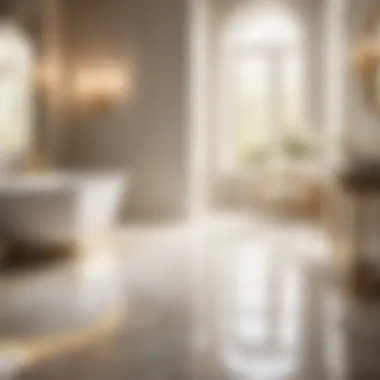Discover a World of Stylish Bath Tiles at Floor and Decor


Materials:
- Ceramic Tile: 50 sq ft
- Porcelain Tile: 30 sq ft
- Glass Mosaic Tile: 10 sq ft
- Thinset Mortar: 3 bags
- Grout: 2 bags
- Tile Spacers: 1 pack
- Backer Board: 3 sheets
- Cement Board Screws: 1 box
- Notched Trowel: 1
- Grout Float: 1
- Tile Cutter: 1
- Drill with Mixer Attachment: 1
DIY Steps:
- Planning Phase: Measure the bathroom area, determine tile selection, and create a layout plan.
- Preparation: Clean the subfloor, install the backer board, and waterproof any necessary areas.
- Tile Installation: Mix the thinset mortar, lay the tiles according to the layout, and use spacers for even spacing.
- Grouting: Apply the grout using a float, clean excess grout with a damp sponge, and seal grout after drying.
- Finishing Touches: Remove spacers, clean tiles, and admire your newly tiled bathroom.
Technical Aspects:
- Tools: Notched trowel, grout float, tile cutter, drill with mixer attachment
- Timing: Allow for drying times between mortar, grout, and sealing.
- Techniques: Ensure even application of mortar, proper alignment of tiles, and thorough grout cleaning.
DIY Project Process:
- Installation Method: Start from the center, work in sections, apply consistent pressure when laying tiles.
- Key Techniques: Use spacers for uniform gaps, check alignment with a level, mix mortar to proper consistency.
- Timings: Allow mortar to set before grouting, clean grout haze within the recommended time.
- Troubleshooting Tips: Adjust tile alignment if necessary, fix unevenly applied grout promptly to maintain a polished look.
Introduction
When it comes to designing and renovating a bathroom, one of the key elements that often gets overlooked is the choice of bath tiles. Bath tiles do more than just cover the floor or walls; they play a crucial role in the overall aesthetics, functionality, and atmosphere of a bathroom. In this article, we will delve deep into the world of floor and decor bath tile options to provide you with a comprehensive guide. By understanding the different types of tiles, design considerations, and installation techniques, you can transform your bathroom into a luxurious and functional space that suits your style and needs.
Understanding the Importance of Bath Tiles


Bath tiles are not merely decorative elements in a bathroom; they serve both practical and aesthetic purposes. From providing waterproofing and durability to enhancing the visual appeal of the space, bath tiles are versatile materials that can elevate the overall design of a bathroom. Understanding the importance of bath tiles involves considering factors such as their resilience to moisture, ease of maintenance, versatility in design, and their ability to add value to your home. By choosing the right bath tiles, you can create a bathroom that meets your functional needs while reflecting your personal style.
Factors to Consider Before Choosing Bath Tiles
Before selecting bath tiles for your bathroom, there are several crucial factors to consider to ensure you make the right choice. Begin by assessing the size and layout of your bathroom, as this will determine the quantity of tiles needed and the design layout options available. Consider the functionality of the space and the level of traffic it will receive to choose tiles that can withstand daily use. Think about the overall design aesthetic you want to achieve, whether it's a modern, traditional, or minimalist look, and select tiles that complement that style. Additionally, factors such as maintenance requirements, slip resistance, and budget constraints are essential considerations when choosing bath tiles. By carefully evaluating these factors, you can make an informed decision that will result in a beautiful and functional bathroom.
Types of Bath Tiles
When it comes to revamping your bathroom, the choice of bath tiles plays a crucial role in transforming the space into a stunning oasis of relaxation and style. Understanding the different types of bath tiles available is paramount in achieving your desired aesthetic and functional outcomes. In this article, we will delve into the various types of bath tiles, including Ceramic Tiles, Porcelain Tiles, and Natural Stone Tiles, providing you with valuable insights and considerations to guide your decision-making process.
Ceramic Tiles
Ceramic tiles are a popular choice for bathroom floors and walls due to their versatility, durability, and cost-effectiveness. These tiles are made from clay that is hardened in a kiln, resulting in a sturdy and water-resistant surface. Ceramic tiles come in a wide range of colors, patterns, and finishes, allowing you to customize your bathroom design according to your preferences.
One of the key benefits of ceramic tiles is their ease of maintenance, making them ideal for high-moisture areas like bathrooms. With proper care, ceramic tiles can retain their beauty and functionality for years to come. However, it's essential to note that ceramic tiles may be prone to chipping or cracking under heavy impact, so proper installation and ongoing maintenance are crucial for long-lasting results.
When choosing ceramic tiles for your bathroom, consider factors such as slip resistance, size, and grout color to ensure a seamless and visually appealing installation. With their budget-friendly nature and endless design possibilities, ceramic tiles are an excellent choice for homeowners looking to achieve a stylish and functional bathroom space.
Porcelain Tiles
Porcelain tiles are known for their durability, water resistance, and versatility, making them a popular option for bathrooms that require high-performance materials. Made from finer clays and fired at higher temperatures than ceramic tiles, porcelain tiles boast excellent strength and are less porous, making them highly resistant to water and stains.


One of the standout features of porcelain tiles is their ability to mimic the look of natural stone or wood, providing a luxurious aesthetic without the maintenance requirements of organic materials. These tiles are available in various sizes, colors, and finishes, giving homeowners ample choices to create unique and captivating bathroom designs.
When selecting porcelain tiles for your bathroom, consider factors such as PEI rating (Porcelain Enamel Institute), water absorption rate, and slip resistance to ensure optimal performance and longevity. While porcelain tiles may come at a higher price point than ceramic tiles, their exceptional durability and aesthetic appeal make them a worthwhile investment for a sophisticated and enduring bathroom space.
Natural Stone Tiles
Natural stone tiles offer a timeless and elegant appeal to bathroom interiors, showcasing the beauty of materials such as marble, travertine, slate, and granite. Each type of natural stone presents distinct colors, patterns, and textures, adding a touch of luxury and sophistication to your bathroom design.
These tiles are renowned for their durability and unique character, as no two pieces are exactly alike, providing a bespoke and exclusive look to your bathroom. While natural stone tiles require regular sealing to maintain their pristine condition and prevent staining, their unparalleled beauty and authenticity are unmatched by synthetic alternatives.
When incorporating natural stone tiles into your bathroom, consider factors such as slip resistance, compatibility with underfloor heating, and sealing requirements to ensure a functional and visually captivating space. Despite being a premium choice, natural stone tiles radiate charm and opulence, elevating your bathroom into a sanctuary of indulgence and refinement.
Choosing the Right Tile Design
When it comes to enhancing the aesthetics and functionality of your bathroom, choosing the right tile design plays a pivotal role in transforming the space into a sanctuary of relaxation and style. The design of your tiles can significantly impact the overall ambiance of the room, making it essential to carefully consider various elements before making a decision.
Color and Pattern
Selecting the right color scheme and pattern for your bathroom tiles is crucial in creating the desired atmosphere. The color of the tiles sets the tone of the space – whether you opt for calming neutrals to promote a spa-like feel or bold hues to inject personality into the room. Patterns can also add depth and visual interest, ranging from traditional designs to contemporary geometric shapes. Consider the size of your bathroom and the amount of natural light it receives to determine the ideal color palette and pattern that will complement the overall design aesthetic.
Size and Shape


The size and shape of your tiles impact the perceived size of the bathroom and can influence the overall design. Larger tiles can make a small space appear more spacious, while smaller tiles can create intricate patterns and visual texture. Rectangular tiles can elongate walls, creating a sense of modernity, while square tiles offer a classic look. Analyze the layout of your bathroom and consider whether you want to highlight certain features or create a cohesive look throughout the space when selecting the size and shape of your tiles.
Texture and Finish
The texture and finish of your bathroom tiles not only affect the visual appeal but also the practicality and maintenance of the space. Smooth, glossy tiles reflect light and are easy to clean, making them ideal for a contemporary bathroom. Matte finishes offer a more subtle and sophisticated look, hiding water spots and fingerprints effectively. Textured tiles provide slip resistance, making them suitable for shower floors. Consider the functionality and desired aesthetic when choosing the texture and finish of your tiles to ensure a balanced and practical design.
Installation Tips and Techniques
When it comes to transforming your bathroom using floor and decor bath tiles, the installation process plays a crucial role in achieving a stunning and long-lasting result. Proper installation not only enhances the aesthetics of your space but also ensures durability and functionality. In this section, we will delve into the key aspects of installation tips and techniques to guide you through the process seamlessly.
Installing bath tiles involves meticulous planning and precise execution to achieve a flawless finish. One of the primary considerations is subfloor preparation, which sets the foundation for the entire tiling project. Understanding the condition of the subfloor is essential to address any issues such as uneven surfaces or moisture problems, ensuring the tiles adhere correctly and avoid potential damage over time. Proper subfloor preparation lays the groundwork for a smooth and durable tile installation.
Grouting and sealing are essential steps in the tile installation process that contribute to both the aesthetics and longevity of the final outcome. Grouting not only fills the gaps between tiles but also enhances the overall look by providing a cohesive finish. Choosing the right grout color can make a significant difference in the visual appeal of the tiled surface. Moreover, sealing the grout helps protect it from moisture and stains, extending the lifespan of your tiles and maintaining their pristine appearance over time.
Once the tiles are installed, proper maintenance and care are crucial to preserving their beauty and functionality. Regular cleaning with suitable products keeps the tiles free from dirt and grime, maintaining a fresh and hygienic environment in your bathroom. Understanding the specific requirements of your tile material is essential to avoid damaging it during cleaning. Additionally, addressing any potential issues promptly, such as cracked tiles or loose grout, can prevent further damage and prolong the lifespan of your tiled surface.
Overall, focusing on installation tips and techniques ensures a successful outcome, where attention to detail and proper care from start to finish results in a bathroom that not only looks exquisite but functions optimally for years to come.
Conclusion
In the realm of floor and decor bath tile options, the concluding aspect plays a pivotal role in tying together all the preceding information and choices made. The essence of the conclusion lies in the transformative power it holds to elevate a mundane bathroom into a luxurious and functional space. It serves as the final touch that harmonizes the chosen tiles with the overall design theme and practical needs of the bathroom. Understanding the significance of selecting the perfect floor and decor bath tiles is essential for achieving a cohesive and visually appealing result. This section will encapsulate the vital points discussed in the article, emphasizing the impact that a well-thought-out conclusion can have on the overall aesthetics and functionality of a bathroom.
Elevate Your Bathroom with the Perfect Floor and Decor Bath Tile
When it comes to elevating your bathroom with the perfect floor and decor bath tile, meticulous attention to detail is paramount. The right choice of tiles can completely transform the atmosphere of your bathroom, enhancing both its beauty and usability. Selecting tiles that not only complement the existing design elements but also provide durability and ease of maintenance is crucial.
The perfect floor and decor bath tile should seamlessly integrate with the overall theme of your bathroom, whether it be a minimalist, contemporary, or traditional style. Consider factors such as color, pattern, size, and texture to create a cohesive and visually appealing space. Opt for tiles that reflect your personal style while enhancing the functionality of the bathroom.
Furthermore, the installation of the chosen tiles should be done with precision and care to ensure a flawless finish. Proper subfloor preparation, meticulous grouting, and sealing techniques, and regular maintenance are essential for preserving the beauty and longevity of the tiles. By paying attention to these details and considerations, you can truly elevate your bathroom with the perfect floor and decor bath tile, creating a space that is both inviting and practical.







